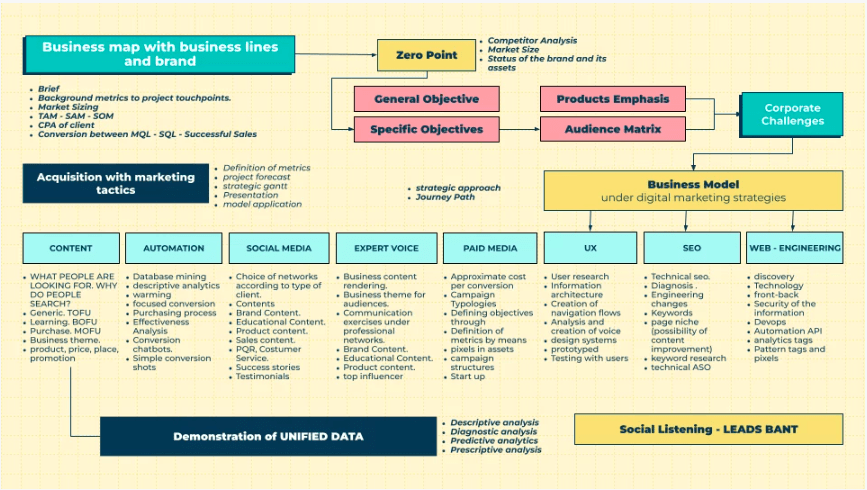Appearing in the top positions of the search engines organically can lead your business to reach its maximum potential, learn everything about technical SEO and its benefits.
Your website does not rank in the top positions of the search engines? Are you not receiving the projected visits under your business plan? If the answer to these questions is affirmative, it is time to approach a crucial subject within a digital marketing strategy: Is your website optimized under the SEO parameters?
If the concept of an optimized website is completely foreign to you, you need to know that this is the only way to make it rank organically within the first places in search engines like Google.
Many times the SEO strategy is focused on creating an attractive and interesting content, designing a unique website and integrating keywords; and although all of the aforementioned actions are completely valid, it is key to remember that the success of a digital marketing strategy lies in comprehensiveness.
What am I referring to with comprehensiveness? To the analysis and work within each aspect of all the digital assets. You can develop a disruptive content strategy, but if you host it in a poorly structured website, you will only be doing half of the job.
The technical SEO is a primordial aspect for your website, because thanks to it search engines, such as google, can track and position it in order for it to rank within the top positions when someone performs a search related to your business or keywords.
What is technical SEO?
SEO, or organic positioning, divides in two: content SEO; which focuses on writing pieces in such a way that they adjust to the search terms, and technical SEO, which aims for the improvement of a website.
Why must a website be improved? Search engines like Google have certain rules that must be followed in order to stand out before other websites. These rules allow that a website is found or interpreted correctly, which results in a higher position on the SERPS (Search Engine Result Pages).
Said aspects to improve go from a title and correct meta-descriptions,going through the architecture of the website, the optimization of the images, how usable it is on mobile devices and the speed with which all of its elements load.
The word ‘technical’ and the aspects to analyze can seem difficult or unattractive, but their importance is vital to have an optimized website that allows your business to reach its commercial goals.
Technical SEO has two main objectives: the first one is to make the pages of a website traceable and indexable, that is, that Google can detect them, understand its content and show them to the public.
The second main objective of technical SEO is to provide the users an optimal experience, as by doing so it reduces the bounce rate (Rate that measures the users that abandon the site after visiting a single page). When a user remains for a longer time in the website he becomes loyal towards the brand, allowing to improve the interaction of your website with your audience.
On-page SEO and off-page SEO: what do they differentiate in?
Technical SEA covers a wide range of characteristics that must be improved in order to reach optimal positioning, which is why it is divided in two “categories”: on-page and off-page.
On-page SEO is the way to tell Google, or any search engine, what your website is about through content. But I am not referring to content such as a blog entry, but as structure: it is important that the configuration of the website is correct, that the HTML code is correctly implemented, that it has an adequate (H) heading distribution, properly generated URLs and even a wide use of keywords.
On the other hand, off-page SEO is a little bit more complicated as it relates with elements which are external to web design. Thanks to it, search engines can know the authority and popularity of your website by analyzing factors such as the external links; third party website links that lead to yours as a reference to a particular subject, presence in social media and user behavior within the sites.
The Pillars of the technical SEO
Within every methodology there are factors that are essential to carry it out correctly; we are going to talk about 5 factors of the technical SEO that cannot be left aside at any time:
- Ease of indexation
Indexation of a website allows search engines to find it and show it to the public, which is why paying attention to these aspects is more than needed.
For this purpose, a correctly structured sitemap XML is required, this file represents a “directory” of the website and eases the tracking of the site. In order to correctly integrate it, pages such as services or products, blogs, about, contact and landings with downloadables must be included; all of those pages that serve the user to understand your business.
The file robots.txt is found within the sitemap, which shows the search engines if a website must be indexed or not, it is crucial to have security over the websites which you are allowing to be found.
For example, if within your robots.txt the products site is disabled, users will not be able to access it through a search, making it impossible for them to know what your business sells or commercializes.
- Website structure
The website structure has two functions; the first one is giving an organized form to the site, so that the users are able to visit the pages coherently. The second function is to create a hierarchy: the page that refers to the history of the business is more relevant than a blog entry from two years ago. By having an established structure the most relevant web pages are prioritized for the search engines and users to easily find them.
- Loading speed.
For Google it is FUNDAMENTAL that a website has a fast loading speed, as it is directly related with the user experience. Therefore, if a website takes time to load and be usable, search engines will not give it any relevance.
To optimize the loading speed extremely heavy files that take time to load must be avoided and a code must be kept clean, that is, maintain the CSS and JavaScript files to a minimum.
Something few people pay attention to is images: there is a lot of visual content within a website, which is why it is important to compress each element to avoid slow loading speeds.
Remember that the maximum time that a user waits for a website to completely load is 3 seconds so you should keep your website under said limit.
- Mobile usability
Currently, mobile devices occupy most of the traffic of a website, which is why you need to make your website display correctly in desktops, tablets and smartphones.
The most relevant factor in this moment is to consider the letter size and the buttons for the functionalities of the website to be available in devices of all sizes.
- Correctly structured URLs
Each URL of your website must be designed to be easily read, both for Google and the user. But what should a URL be like? Ideally, it should be short, contain no symbols and each word be separated by dashes.
Likewise it must show the hierarchy of your website: for example, the URL of a blog entry must be organized in such a way so that the user understands the category to which it belongs:
www.yourwebsite.com/blog/category/sub-category/title-of-the-entry
In addition to these five factors there are subjects such as security, duplicity of pages, correctly implemented code and other elements for which it is necessary to have the knowledge of a web developer that speaks this language and perfectly understands how to organize each element coherently.
Technical SEO is an aspect within your digital marketing strategy that cannot be left aside, as thanks to it your organic reach is going to be much more effective and you will be able to have a website that meets the usability expectations of the users, making your brand stronger and having proper growth.







